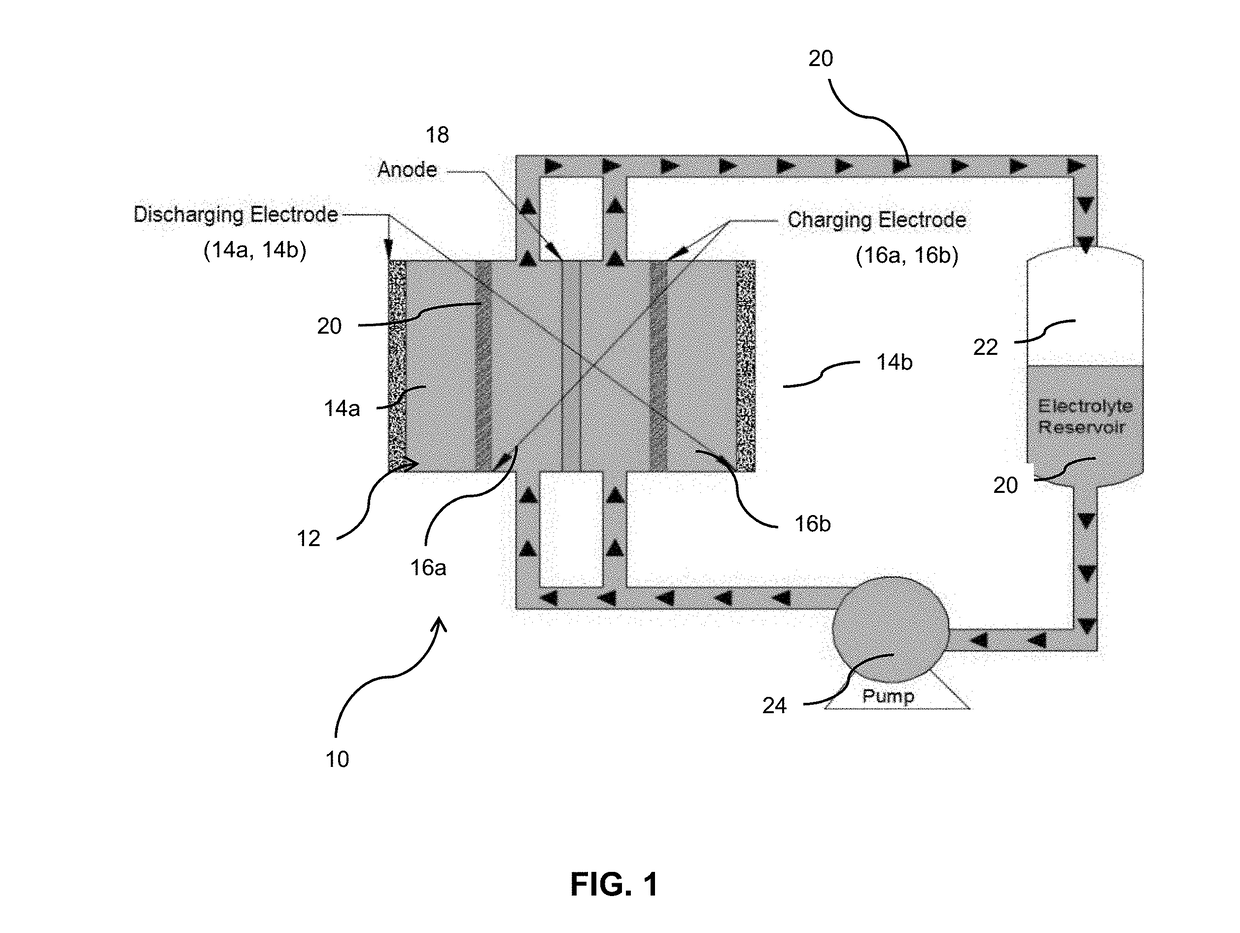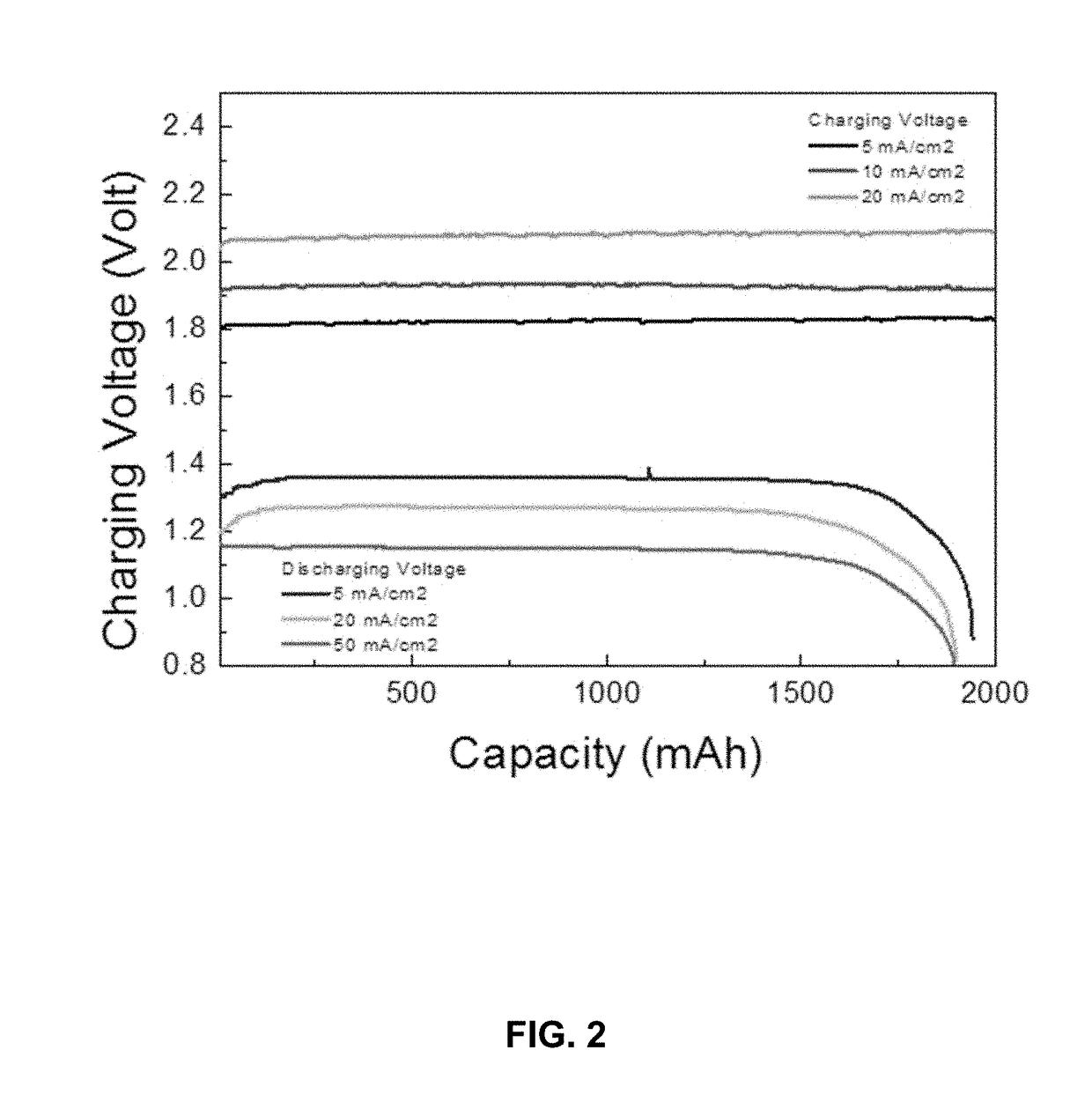Tri-Electrode Zinc-Air Battery with Flowing Electrolyte
a zinc-air battery and electrolyte technology, applied in the field of electrochemical energy conversion and storage devices, can solve the problems of fading of battery performance, hammering the commercialization of rechargeable zinc-air batteries, and corrosion of carbon contained in cathodes
- Summary
- Abstract
- Description
- Claims
- Application Information
AI Technical Summary
Benefits of technology
Problems solved by technology
Method used
Image
Examples
example a
[0040]A tri-electrode single flow zinc air battery was prepared comprising: a piece of 2 cm×3 cm Ni-foam as the charge cathode; a piece of 2 cm×3 cm catalytic air electrode as the discharge cathode; a piece of 2 cm×3 cm copper sheet as the anode; an electrolyte comprising 6 M KOH and 0.4 M K2Zn(OH)4; and an electrolyte flow system comprising a pump, a tank, and plastic tubes.
[0041]The discharge cathode was prepared by mixing graphite powder, Co3O4 (D50=2 um), carbon nanotubes and PTFE (emulsion) in isopropanol to form a slurry. The mass ratios of each component was 65%:10%:5%:20%. The slurry was coated and pressed onto a piece of nickel foam, then dried in an oven. The electrode was roll pressed to a thickness of 0.5 mm, and heat the pressed at 310° C. for 30 min to increase its hydrophobicity.
[0042]The battery was assembled as shown in FIG. 1. As shown, the battery 10 includes a housing 12 within which is contained two discharge cathodes 14a and 14b, two charge cathodes 16a and 16b...
example b
[0045]A tri-electrode single flow zinc air battery was assembled as in Example A. The charge cathode was a piece of 0.2 mm thick stainless steel (304) mesh and the discharge cathode comprised graphite powders, MnO2 (EMD Grade), carbon nanotubes and PTFE, the mass ratio of each component being 65%:10%:5%:20%. The anode was formed from a piece of stainless steel sheet. The electrolyte comprised 4M NaOH and 0.8 M Na2Zn(OH)4.
example c
[0046]A tri-electrode single flow zinc air battery was assembled as in Example A. The charge cathode was a piece of 0.2 mm thick titanium mesh and the discharge cathode comprised a platinum / carbon (Pt / C) catalyst layer sprayed onto the surface of a porous carbon gas diffusion layer. The anode was a piece of copper foam. The electrolyte comprised 8 M KOH and 0.2 M K2Zn(OH)4.
PUM
| Property | Measurement | Unit |
|---|---|---|
| time | aaaaa | aaaaa |
| thickness | aaaaa | aaaaa |
| thick | aaaaa | aaaaa |
Abstract
Description
Claims
Application Information
 Login to View More
Login to View More - R&D
- Intellectual Property
- Life Sciences
- Materials
- Tech Scout
- Unparalleled Data Quality
- Higher Quality Content
- 60% Fewer Hallucinations
Browse by: Latest US Patents, China's latest patents, Technical Efficacy Thesaurus, Application Domain, Technology Topic, Popular Technical Reports.
© 2025 PatSnap. All rights reserved.Legal|Privacy policy|Modern Slavery Act Transparency Statement|Sitemap|About US| Contact US: help@patsnap.com



